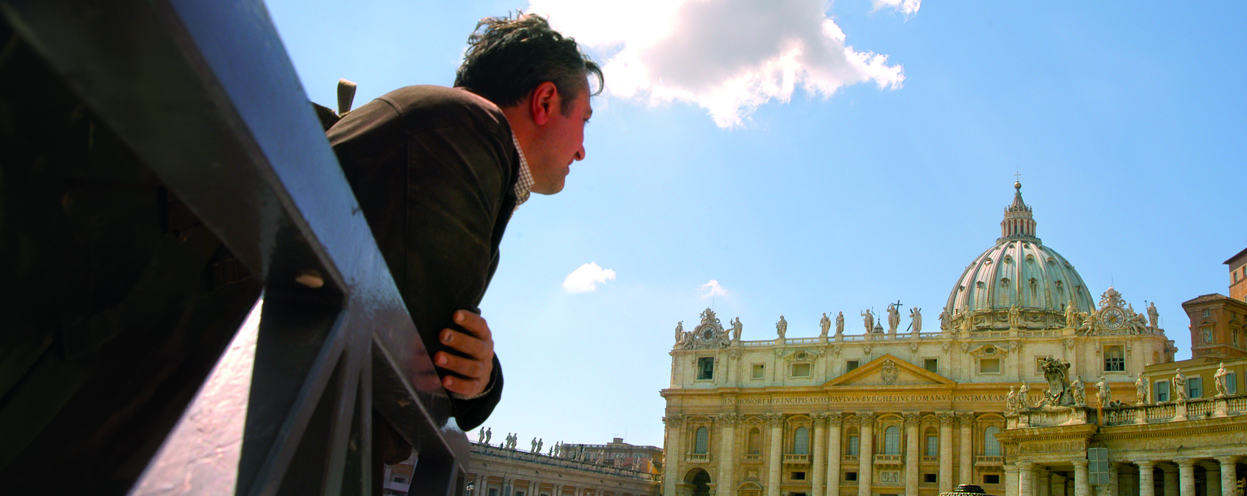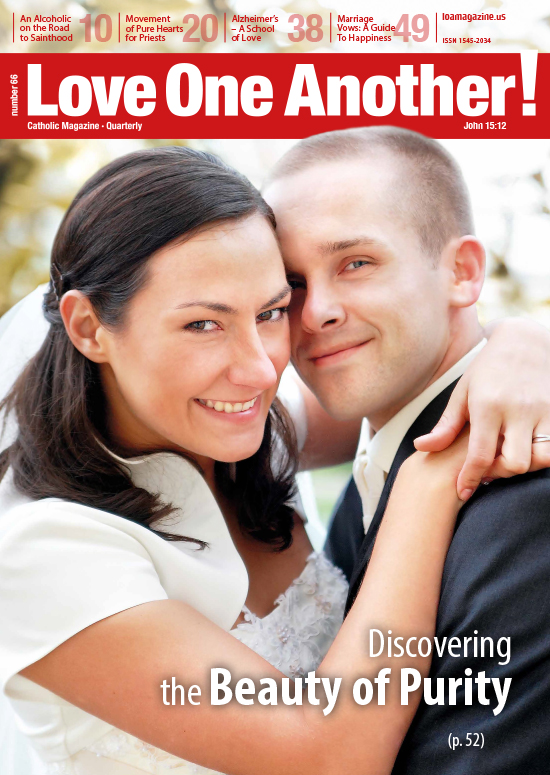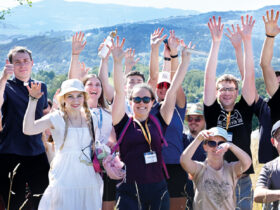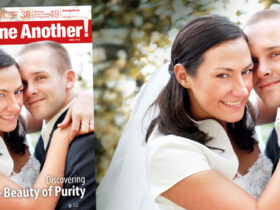Seek And You Shall Find

Jesus assures us that whoever seeks the truth sincerely will find it (cf. Luke 11: 9). In this truth resides the ultimate meaning of human life. The remarkable story of the conversion of Scott Hahn, one of America’s leading contemporary Catholic theologians, is a dramatic illustration of how an honest, uncompromising seeking after the truth always leads to the discovery of that truth; and how the fullness of God’s revelation is found only in the Catholic Church.
Before discovering his true home in the Catholic Church where Jesus Christ invites all sinners without exception into communion with Himself, Scott Hahn underwent a fascinating spiritual and intellectual journey: from scorn and hatred of the Catholic Church to his discovering within her the greatest treasure offered by God to mankind.
Roots
Scott Hahn was born into a traditional Protestant family and baptized in the Presbyterian Church. In his youth, however, he broke with religious practice and began leading a wild, unruly life. After committing several petty crimes, he appeared before juvenile court and received a six-month suspended sentence. Thanks to a charming girl called Kathy, he began attending meetings of Young Life, a Christian group whose goal was to spread the gospel of Jesus Christ among young people who had no interest in church. During one of these meetings, the retreat leader challenged him to gaze intently on the crucified Christ, whenever he felt the temptation to make light of his sins. Thus, having come to realize that his sins also contributed to the Christ’s death on the cross, Hahn decided to entrust his whole life to Jesus. From that moment on, he underwent such a radical transformation of thought, values, and behavior that all his former friends left him. Hahn fell in love with the Bible. Martin Luther and John Calvin became his supreme authorities in matters of faith. He soaked up all the prejudices and hostility that Protestants nursed toward the Catholic Church. He became convinced that the Catholic belief in the real presence of Christ in the Eucharist was sheer idolatry. In his hatred of the Catholic Church, he strove by every means possible to win over Catholics and free them from all the superstitions and errors they were mired in—for of this he was sincerely persuaded. The ignorance of the young Catholics he came in contact with staggered him. They knew neither the Bible, nor the Catechism, nor the basic teachings of their Church.
After finishing college, Hahn decided he wanted to become a pastor and lead people to Jesus. He entered a master’s program in biblical studies and theology. At the same time, on August 18, 1979, he married his beloved Kimberly. The couple placed Jesus at the center of their marriage and looked forward to having a family of five or six children.
No compromise
Hahn was uncompromising in his search for the truth. With the doggedness of a master detective, he began investigating the texts of Holy Scripture to prove that it was in the Protestant Church that the teachings of the Bible were most fully expressed and lived out. In this search, Hahn’s closest friend and companion was his fellow student, Gerry Matatics. As Presbyterians, both men were deeply convinced the Catholic Church was the Whore of Babylon of the Apocalypse, and the Pope, the Anti-Christ. At the same time, Hahn’s wife, Kimberly, who was also studying theology, chose contraception as a topic for a seminar paper. In her research she discovered that until 1930 all Christian churches had considered contraception an evil, regardless of the circumstances. In this respect, Holy Scripture was unequivocal: the use of contraception went against natural law and was a profanation of the marriage covenant, since it prevented a married couple from a total mutual self-giving. Since 1930—Kimberly discovered—the Catholic Church was the only Christian confession to remain faithful to the teachings of the Bible regarding marriage; and the Church continued with full conviction and courage in the face of so much opposition and hostility to preach the revealed truth about the sin of contraception. The discovery led Hahn and Kimberly to take a radical step forward: the couple renounced their former practice of contraception. They entrusted their entire marriage to God and opened themselves up with total confidence to the new life that God Himself would plan for them.
Kimberly and Scott Hahn had now confided every area of their life to Jesus their one Lord. Even while living on
a limited budget, they regularly gave away a tithe of their earnings for the needs of the Church, and yet they continued to experience the generosity with which Jesus satisfied all their needs. They observed the Sabbath strictly; on Sundays, they put aside their studies, which they considered as work, even when there was an examination scheduled for the following Monday.
Discovering the error of Luther and Calvin
At this stage of his search for the truth, Hahn’s sole authority was the Bible. So as to better understand the biblical texts, he studied Greek and Hebrew.
From his studies, Hahn acquired a new understanding of the term covenant. Protestants understood a covenant as a contract. Holy Scripture, on the other hand, spoke of a covenant as a spiritual family relationship—a bond that went deeper than natural kinship. God’s covenant with his Chosen People in the Old Testament meant that God became a Father for the Israelites, and they became his family. Thanks to the New Covenant, which Christ made on behalf of all of humanity, man became a child of God, and the human race one family. Hahn’s study of the Bible led him to reject Luther and Calvin’s teaching of justification and the juridical terminology they used. Luther and Calvin claimed that justification came from faith alone and not through faith worked out in love, as the Catholic Church taught. Hahn discovered that in his German translation of Romans 3: 28, Luther had altered the text to suit his preconceived notions. The original text stated that “a person is justified by faith,” whereas Luther added the word “alone,” which was a clear misuse and falsification of the biblical text.
Hahn discovered that justification was not a juridical decree. God was above all a Father— not a Judge. Through Christ He gave us a share in God’s divine life and made us His children. In Ephesians 2: 8-10, Saint Paul stressed that faith was a totally unmerited gift of God to man and did not come from works; but it did enable man to do good. Our faith was alive only when we performed good works. Without these, it was dead.
It became clear to Hahn that nowhere did Holy Scripture state that we were justified by faith alone. Thus, one of the central tenets of Protestantism, namely that we were justified without works and only through faith, turned out to be unbiblical. It cost Hahn a great deal to acknowledge that in this matter at least Luther was mistaken. The Bible clearly taught that a person was “justified by works and not by faith alone” (Jas 2: 24). Saint Paul taught that faith was to work itself out through love (cf. Gal 5: 6). “If I … comprehend all mysteries and all knowledge; if I have all faith so as to move mountains but do not have love, I am nothing” (1 Cor 13: 2). Faith, therefore, was a total gift of God and our response to this gift was expressed in concrete works.
Longing for unity
Shortly after completing his studies, Hahn accepted the post of pastor and teacher at a Presbyterian church in Virginia. At first, his duties consisted in delivering a sermon every Sunday and conducting two Bible meetings a week. The congregation found his exposition of covenant as a Divine family relationship—all based on Hebrews and other letters of the New Testament—compelling. His study of Paul’s letter and the Gospel of St. John convinced him that the sacraments and the liturgy played an important role in the life of the Christian community. Realizing the importance of liturgy in upholding the people’s covenant with God, he decided the main aim of his sermons should be to prepare the faithful for receiving Communion. Only once did Jesus use the word “covenant”—and this precisely when instituting the Eucharist. Presbyterians received communion only four times a year. Hahn decided to change this; he proposed that the congregation receive Communion every Sunday. To the objections of those who feared this might cause them to fall into dull routine, Hahn replied that Communion was the renewal of their covenant with God, and this renewal ought not be so drastically limited. It would be like limiting the renewal of the marriage covenant by restricting the marital act to a few times a year.
Hahn’s congregation unanimously accepted his proposal of weekly Communion. It became the central point of a celebration, which Hahn, as in the early Church, called the Eucharist. As time went on, Hahn came to realize—this to his great amazement—that the Catholic Church, to which he was so fiercely opposed, provided cogent answers to many of his questions.
At this time, Hahn was teaching Scripture classes at a private bible college. His students listened raptly to his lectures on God’s covenant with mankind. Beginning with God’s personal covenants with Adam, Noah, Abraham, Moses, and David, he went to elaborate on the New Covenant concluded by Christ, which established the Family of God and embraced all the nations of the world, i.e. a universal or catholic family (from the Greek, katholikos) embracing the whole world. Obviously, Hahn could not accept that this was the Catholic Church.
After one of these classes, a student came up to tell him that a poll she had just conducted in class indicated that he would become a Catholic. The very same day his wife told him that with his views he would become the antithesis of Luther. Hahn angrily dismissed this as absurd. How could he who considered himself a slave of the word of God ever become the antithesis of Luther?
Holding his newborn first son in his arms, Hahn, pastor of a divided Presbyterian church, wondered to which Church his child would belong. He yearned for the unity of God’s family—for the unification of the Churches. He prayed for the grace to be faithful to the word of God, to live by it every day, and to proclaim it with courage in every circumstance. Above all, he prayed that his mind and heart be open to the Holy Spirit, who spoke through the texts of Holy Scripture.
The Truth of the Eucharist
While preparing for his classes, Hahn spent several weeks examining the sixth chapter of St. John’s Gospel, which contained Christ’s central discourse on the Eucharist (cf. John 6: 22-71). Hahn had always been convinced the Eucharist was merely a symbol; however, his scrupulous study of the text of the Eucharistic discourse revealed that Jesus was not speaking metaphorically. His own words testified to this, as did also the expressions of outrage and indignation of His listeners, who objected, “How can he give us his flesh to eat” (v. 52); “This saying is hard. Who can accept it?” (v. 60). Christ’s words were unambiguous: “my flesh is true food, and my blood is true drink. Whoever eats my flesh and drinks my blood remains in me and I in him” (vv. 55-56). Jesus was clearly speaking about his real presence in the Eucharist. For the first thousand years of the Church’s existence no Christian had ever questioned this truth; all had believed in it. For Hahn this was a shocking discovery, for this teaching was also the doctrine of the Catholic Church. Fear of losing his job prompted him to gloss over John 6 in his seminar classes; he steered clear of the problem of Christ’s real presence in the Eucharist. And so, under the influence of his study of Holy Scripture, Hahn came to realize that the liturgy and the sacraments were meant to play a primary role in the Church. Alas, this was not the case in the Presbyterian Church. At this point, Hahn considered joining the Episcopal Church. When he informed his wife of his intention, she burst into tears, insisting she would never stop being a Presbyterian.
Is Holy Scripture the sole basis of faith?
One of the two pillars of the Protestantism was the doctrine that we are saved by faith alone (sola fide). The other was that Holy Scripture (without Tradition) is the sole authority and source of faith (sola scriptura). These doctrines were the main cause of the break between Catholics and Protestants. Protestants claimed we were justified only through faith and that the Bible was our only authority. In his Bible-based lectures, Hahn questioned the principle of sola fide on the grounds that it was unbiblical; however, he continued to teach that Scripture was the sole basis of faith (sola scriptura). One day he was asked by a student in class to show where in the Bible it was stated that the Bible was the sole authority. The flustered professor replied that this was a stupid question; to which the student, looking him straight in the eye, replied, “Then give me a stupid answer!” Thus pinned down, the professor cited Matthew 5: 17 and 2 Timothy 3: 16-17. But these were not convincing arguments. Then the student asked the professor to comment on the verse, “Therefore, brothers, stand firm and hold fast to the traditions that you were taught, either by an oral statement or by a letter of ours” (2 Thess 2: 15). Unwilling to comment on this text, Hahn deferred the discussion to another time. But the student’s question so unsettled him that he kept asking himself, even while praying, if there were texts in the Bible that supported the Protestant principle of sola scriptura. Weeks of rooting through the Bible brought no results. So Hahn sought help from the best American theologians. But neither did this bring the desired results. The answers he received were either perfunctory or of the kind: “why bother me with stupid questions?” But Hahn was not put off. He asked to be given a stupid answer. All acknowledged there was no scriptural warrant for sola scriptura; that it was merely a theological assumption. There was simply no biblical text that stated that Holy Scripture was the sole authority. On the other hand, Scripture did urge the faithful to hold fast to tradition, whether oral or written (cf. 2 Thess 2: 15). Scripture also stated that that the “pillar and foundation of the truth” was the Church (cf. 1 Tim 3: 15). But the question remained: which Church?
Hahn became increasingly distressed and agitated. Earlier he had seen the collapse of one of Protestantism’s pillars (sola fide), and now the second (sola scriptura) was crumbling before his eyes. Just at this time, the rector of the bible college offered him the position of dean in recognition of his universally admired teaching abilities. Hahn declined the offer and also resigned his pastorate. His conscience would not allow him to teach doctrines of which he was not persuaded. Hahn was uncompromising in his search for the truth. His trust in God being boundless, he desired to know and love all that the Creator had to reveal to him in Holy Scripture.
On the road to the Catholic Church
By a happy coincidence, Hahn came into possession of a valuable book collection, which had belonged (as he would later discover) to a renowned Catholic biblical scholar. For hours every evening he pored over these Catholic books. The depth of these works astounded him. After a few weeks, there arose in him the strong conviction that Christ was calling him to the Catholic Church. The thought terrified him, for until now he had been persuaded that no thinking Christian could be a Catholic. He begged God to enlighten him. Could the fullness of revealed truth indeed reside in the Catholic Church? At this time, Hahn was holding long theological discussions with his friend Gerry Matatics who shared both his fascination with the Bible and his hostility toward the Catholic Church. Hahn confessed to him that he had in his possession a large collection of Catholic books among which he had discovered some of the world’s greatest theological minds. Among these were Joseph Ratzinger, Jean Danielou, Hans Urs von Balthasar, Henri de Lubac, and R. Garrigou-Lagrange. Wishing to discover them for himself, Matatics read all the books Hahn had mentioned to him—this in the course of a single month. On reading them, he came to the conclusion that the entire doctrine of the Catholic Church had a biblical basis, and that the Catholic faith was a priceless treasure for all of mankind. Together the two men desperately sought to pick holes in the Catholic teachings, but each time they found answers that neither of them could question.
Final obstacle: the cult of Mary
Around this time, Hahn received a plastic rosary in the mail. On looking at it, he realized there remained but one more obstacle to his joining the Catholic Church; namely, the cult of Mary. In the silence of his office, he turned to God in earnest prayer, begging Him to help him understand the Catholic teaching about Mary, the Mother of Christ; then, reciting the rosary for the first time in his life, he prayed for an intention that seemed to him hopeless. Three months later, Hahn was satisfied his request had been answered. He thanked God for His infinite mercy and begged forgiveness for his blindness and ingratitude. From that moment on, he began praying the rosary daily. He came to realize that the rosary drew all its power from the mystery of the Incarnation. It was also an immensely effective weapon against the powers of evil. God chose Mary in order that the Second Person of the Holy Trinity might take real human flesh in her womb and thus enable Him to accomplish the work of our redemption.
Word of Hahn’s flirting with the Whore of Babylon quickly spread among his friends and acquaintances. One of them, named Chris, called him up and asked him ironically if he were now worshipping Mary. Hahn set him straight on the point. Catholics did not worship Mary; they honored her. Chris said this made no difference, since the honor accorded to Mary by Catholics had no Biblical warrant. Hahn’s reply was decisive. First of all, he told his friend that Jesus lived by the Decalogue and thus obeyed the Fourth Commandment, which said, “Honor thy father and thy mother.” The Hebrew word for “honor” meant literally to “render glory.” Jesus Christ honored both His Heavenly Father and His earthly mother, Mary. Clearly, then, all believers in Christ ought to imitate Him by rendering glory to Mary, even as He did. This was the basis of the cult of Mary in the Catholic Church. In the Bible Mary herself said, “behold, from now on will all ages call me blessed” (Luke 1: 48). The rosary prayer was only a fulfillment of these words of the Gospel.
Hahn became convinced that the daily recitation of the rosary helped him to delve ever deeper into the theological meaning of the Biblical texts. The prayer fostered both the sense of faith and theological intuition. It sharpened the intellect and taught the “logic of love.”
Hahn discovered the interior life of the Holy Trinity as the one eternal Holy Family: Father, Son, and Spirit. He was now persuaded the Catholic Church was the earthly image of the Divine Family.
The Pope and the Teaching Authority of the Church
To make sure that they were on the right path, Hahn and Matatics arranged a meeting with one of the leading Calvinist theologians, Dr. John Gerstner, who styled the Catholic Church as “Satan’s synagogue.” During the discussion Gerstner requested a biblical warrant for the institution of the papacy. Hahn cited Matthew 16: 17-19, where Jesus gave Simon a new name—Peter (i.e. Rock). Upon Peter the Rock—He declared—He would build His Church and thus He conferred upon Peter the keys to the Kingdom of Heaven. Here Jesus was echoing the prophet’s words in Isaiah 22: 20-22, where we read that King Hezekiah, after appointing Eliakim governor of his palace, entrusts to him the “keys of the kingdom.” In conferring on Peter the “keys to the kingdom,” Jesus established the Petrine Office, so that in His name Peter might govern the Church—His kingdom on earth. Peter’s office was handed down to his successors.
Hahn explained that at the heart of Holy Scripture was the notion of covenant as a sacred family bond between God and His people. The biblical notion of a Divine family informed and made sense of the entire teaching of the Catholic Church. Hence the Church spoke of Mary as the mother of all believers, of the Pope as father, of the saints as our brothers and sisters, and the liturgical feasts as family celebrations.
Throughout their lengthy discussion with Dr. Gerstner, Hahn and Matatics received no satisfactory explanation to their questions. This only further persuaded them of the truth of Catholic teaching. They felt deceived by the doctrines of Luther and Calvin.
They informed Gerstner that since the time Luther broke ties with the Catholic Church there had arisen over 25,000 different Protestant denominations and that, according to experts, five new ones were springing up every week. Every one of these breakaway groups claimed the Bible as their authority and the Holy Spirit as their guiding inspiration. Hahn used the analogy of the founding of the United States of America. The founding fathers of America did not limit themselves to writing a constitution, but went on to create a government consisting of a president, senate, congress, and supreme judiciary. It was the task of these governing institutions to interpret the constitution and put its principles into action. If something like this was necessary to govern a single state, then how much more necessary was it to have appropriate structures for governing the community of the Church, which embraced the whole world. Jesus said to Peter, “You are Peter [the Rock], and upon this Rock I will build my Church, and the gates of the netherworld shall not prevail against it” (Mat 16: 18). In addition to Holy Scripture and His Spirit, Jesus gave us the Church, along with her teaching authority, the Pope, bishops, and councils, whose task it was to correctly interpret the Scriptural texts and put them into action.
Hahn explained to Gerstner that nowhere did the Bible state that the word of God was found only in Holy Scripture. But it did clearly state that the word of God was present in the tradition of the Church (2 Thes 2: 15; 3: 6) as well as in her teaching and proclamation of the word (1 Pet: 25; 2 Pet 1: 20-22; Matt. 18: 17). Holy Scripture provided warrant for the Catholic doctrine of solum verbum Dei (word of God alone). But nowhere did it provide warrant for the Protestant claim of sola scriptura (word of scripture alone). Dr. Gerstner stubbornly insisted the teachings of the popes and councils contradicted the Bible, but he failed to give convincing arguments, which would support his positions.
Hahn asked him to specify whose interpretation of Holy Scripture he had in mind. It was a matter of historical record that the canon of the New Testament writings was decided in 393 AD at the synod of Hippo and confirmed four years later at Carthage. The decisions of these synods were presented to the Pope, who approved and ratified them. Thus the infallible authority of the Church already existed, for it was she who decided which texts of Holy Scripture were or were not canonical, and what interpretation to give them.
Papal infallibility
But Gerstner protested: where was the biblical warrant for the Catholic claim that Christ guaranteed Peter infallibility in his teaching? Hahn pointed out that both Protestants and Catholics were agreed on this by the very fact that the New Testament contained two of Peter’s letters. Thus there were no grounds to question Peter’s infallibility and that of his successors, when, in the name of Christ, they taught on matters of faith and morals. If we believed that the books of the New Testament were the inerrant word of God, then it would be absurd to hold that the canon had been settled by councils and popes, to whom God had not imparted the gift of infallibility.
Despite these arguments, Gerstner insisted that Protestants recognized no infallible authority apart from the Bible. As to the canon of the books of New Testament, he claimed that all we had was a fallible collection of infallible documents.
Hahn and Matatics were disappointed by the course of these discussions. The poverty and inconsistency of the message of the Protestant Christian tradition astounded them. After all, the logical thing would be to hold that the ultimate authority of every Christian was either the Bible and the Church, or neither of the two.
I found my family; and that family was the Family of God
After these discussions, Hahn had no doubt that Jesus was calling him into communion with the Catholic Church. There was only one problem. When should this take place? With Kimberly’s agreement, he decided to move to Milwaukee and enroll in the Catholic university’s doctoral program in theology and biblical studies. There he discovered the depth of truth and beauty of Catholic teaching. There he met Catholic students who lived out their faith with joy and were not afraid to defend it. One of them, John Grabowski, introduced Hahn to the liturgy of the Holy Mass at his parish church. Another student, Monica Migliorino, brought both Hahns into the pro-life movement and the intense struggle against abortion and pornography.
This was also a time when Hahn came into close contact with fervent Catholics of the Opus Dei movement. From them he learned a robust Catholic way of life and picked up practical pointers about daily prayer, work, and apostleship.
Hahn’s spiritual transformation now entered into what he called a romantic phase. His anti-Catholic prejudices began to fall away. In their place he began to see his family—his home. One day Hahn decided to go to a Catholic Mass, which in the evangelical and Calvinist tradition was seen as the worst blasphemy. The liturgy delighted him. He came to see how deeply it was rooted in Holy Scripture.
At the consecration, when the priest raised the Host, Hahn found himself saying with all his heart, “My Lord and my God! It really is you, Lord! I want to be fully united with you.”
The next day, Hahn went to Mass again. From then on, he attended Mass every day. He writes in his book: “I do not know how to say it, but I fell completely in love with Our Lord present in the Eucharist! His presence in the Blessed Sacrament was powerful and personal for me. Sitting at the back of the church, I began to kneel and pray with the others, who became like brothers and sisters to me. I was not an orphan! I had found my family, and that family was the family of God” (Rome Sweet Home).
Taking part in the daily mystery of the Holy Mass, Hahn felt he was renewing the covenant concluded by his Savior Jesus Christ. He felt Christ wanted to be received not only spiritually, but also physically, for in this the fullness of the Gospel was expressed. Every day after Mass, he knelt before the Blessed Sacrament and prayed the rosary. He earnestly begged that he might come to know God’s will in every respect and carry it out. While so praying, he could feel, almost palpably, that Jesus was assisting him through Mary’s intercession.
Two weeks before Easter of 1986, Gerry Matatics called Hahn to tell him that he and his wife were to be received into the Catholic Church on the Easter Vigil. For Hahn this was shocking news. So he turned to God in petitionary prayer: “Lord, what do you want of me?” he asked. To his great surprise, he heard the reply, “And what, my Son, do you really want?” To which Hahn replied, “Father, I want to come home. I want to receive you, Jesus, in the sacrament of the Eucharist.” Then he heard the Lord’s calm answer: “I am not preventing you.” Hahn realized that putting off the decision to enter into communion with the Catholic Church would be an act of disobedience. He informed his wife Kimberly of his decision and asked for her prayers. This was a difficult experience for her. As a practicing Presbyterian, she felt betrayed and let down by her husband. For Scott, his wife’s lack of acceptance of his decision was also a painful experience. He confided the matter to God in a prayer of the heart. By way of an answer, he heard, “Scott, you require the fullness of grace in the Eucharist, so that I may love them through you.”
Hahn informed the pastor, Monsignor Bruskewitz of his decision, who in turn fixed the date of his reception into the Catholic Church. And so, on that memorable day, he received a conditional baptism, the sacrament of reconciliation, and Holy Communion. After receiving First Holy Communion, Scott hugged his wife close to him. He felt as if Christ who was present in him in the Eucharist were clasping both him and Kimberly to Himself. Jesus spoke to him in the silence of his heart: “Scott, this does not depend on feelings. Since I have entrusted myself to you in the Sacred Host, you may trust in me more than ever before. I am now present in you, in your soul and in your body, as never before.” Kimberly followed in her husband’s footsteps four years later, but not before undergoing her own painful search for the truth. Thus did Scott and Kimberly Hahn come to discover the greatest treasure, which is the Risen Christ present in the Universal Church that He Himself founded—the Catholic Church. It is there that Jesus teaches, forgives all sins, heals all wounds of the heart, raises up from the greatest failures and calamities, and leads to the fullness of joy in heaven.
Scripture says, “[Strive] to preserve the unity of the spirit through the bond of peace” (Eph 4: 3) and, “I urge you, brothers, in the name of our Lord Jesus Christ, that all of you agree in what you say, and that there be no divisions among you, but that you be united in the same mind and in the same purpose” (1 Cor 1: 10). How is it the “biblical” Churches do not heed this simple admonition and multiply divisions instead?






